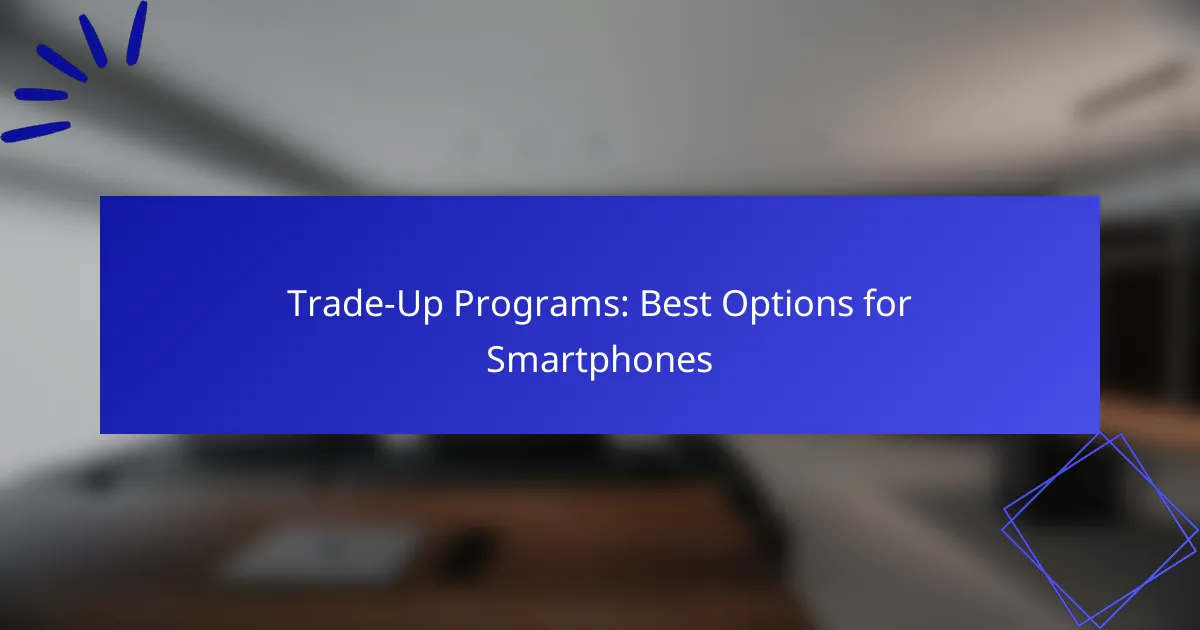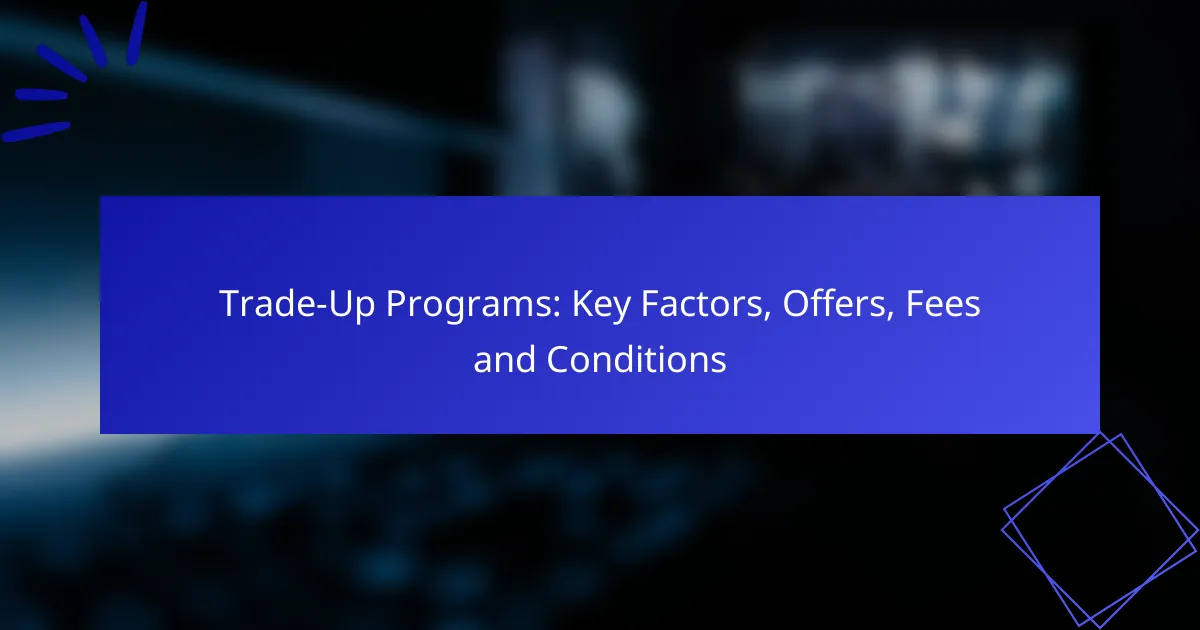Trade-up programs for smartphones provide an efficient way for consumers to exchange their old devices for credit towards new purchases. By assessing the condition of the device, these programs offer varying credit values and streamline the shipping process, making upgrades more accessible. With benefits like cost savings and environmental sustainability, exploring the best options can help you make an informed decision when upgrading your smartphone.

What are the best trade-up programs for smartphones in the US?
The best trade-up programs for smartphones in the US offer consumers a straightforward way to exchange their old devices for credit towards new purchases. These programs vary in terms of value, eligibility, and ease of use, making it important to compare options before deciding.
Apple Trade In Program
The Apple Trade In Program allows users to trade in their old iPhones or eligible smartphones for credit towards a new device. The process is simple: customers can either visit an Apple Store or use the online trade-in tool to get an estimated value based on the device’s condition.
Apple offers a wide range of trade-in values, often reaching up to several hundred dollars for newer models. It’s essential to ensure your device is in good working condition to maximize the trade-in value.
Samsung Trade-In Program
Samsung’s Trade-In Program provides users with the opportunity to trade in their old smartphones for credit towards new Samsung devices. This program is accessible both online and in-store, making it convenient for users to participate.
Trade-in values can vary significantly, with newer models fetching higher credits. Samsung often runs promotions that can increase the trade-in value, so checking for current offers is advisable before making a decision.
Best Buy Trade-In Program
The Best Buy Trade-In Program allows customers to trade in various electronics, including smartphones, for store credit. Users can check the estimated value of their device online and then bring it to a Best Buy location for evaluation.
Best Buy typically offers competitive trade-in values, and the credit can be used towards any purchase in-store or online. Be aware that the final value may depend on the device’s condition and model.
Amazon Trade-In Program
Amazon’s Trade-In Program enables users to send in their old smartphones in exchange for Amazon gift cards. The process involves selecting the device on the Amazon website, receiving an estimated value, and then shipping the device using a prepaid label.
This program is particularly appealing for frequent Amazon shoppers, as the trade-in value can be used for future purchases. However, the values may not be as high as those offered by manufacturer-specific programs.
Walmart Trade-In Program
The Walmart Trade-In Program allows customers to trade in their smartphones for Walmart gift cards. Users can check the value of their device online and then bring it to a participating Walmart store for assessment.
Walmart’s trade-in values are generally competitive, but it is wise to compare them with other programs to ensure you get the best deal. The process is straightforward, making it a convenient option for Walmart shoppers.

How do trade-up programs work?
Trade-up programs allow consumers to exchange their old smartphones for credit towards a new purchase. These programs typically assess the device’s condition, provide a credit value, and manage the shipping process to facilitate the exchange.
Assessment of device condition
The assessment of a device’s condition is a crucial step in trade-up programs. Most companies require users to answer a series of questions about the phone’s functionality, physical appearance, and any existing damage. Common categories include screen condition, battery health, and overall performance.
Some programs may offer online tools or apps to help evaluate the device, while others may require users to send in the device for a professional inspection. Depending on the findings, the credit value can vary significantly, often ranging from a few dollars for damaged devices to several hundred for like-new models.
Credit towards new purchase
Once the device condition is assessed, users receive a credit that can be applied to their next smartphone purchase. This credit can significantly reduce the cost of a new phone, making it an attractive option for many consumers. The credit amount is typically communicated upfront, allowing users to make informed decisions.
It’s important to note that the credit may vary based on promotions or specific models being purchased. Always check the terms and conditions to understand how the credit applies and if there are any limitations.
Shipping and handling process
The shipping and handling process for trade-up programs usually involves sending the old device to the retailer or manufacturer. Most programs provide a prepaid shipping label, making it easy for users to send their devices without incurring additional costs. Packaging instructions are often included to ensure the device is protected during transit.
After the device is received, the assessment process begins, which can take a few days to a couple of weeks. Users should keep track of their shipment and check for confirmation once the device has been received. Delays in shipping or processing can affect the timeline for receiving credit, so it’s advisable to plan accordingly.

What are the benefits of trade-up programs?
Trade-up programs offer several advantages, including cost savings on new devices, environmentally friendly options, and convenience in upgrading. These programs allow consumers to exchange their old smartphones for credit towards a new purchase, making the transition smoother and more affordable.
Cost savings on new devices
One of the primary benefits of trade-up programs is the potential for significant cost savings. By trading in an old smartphone, users can receive credit that reduces the price of a new device, often by hundreds of dollars. For example, a trade-in value might range from $50 to $300, depending on the model and condition of the old phone.
It’s essential to compare trade-in offers from different retailers and manufacturers to ensure you get the best deal. Some companies may provide promotional bonuses or higher trade-in values during specific periods, which can further enhance savings.
Environmentally friendly option
Participating in a trade-up program is an environmentally responsible choice. By trading in your old smartphone, you help reduce electronic waste, which is a growing concern worldwide. Many trade-in programs ensure that old devices are recycled or refurbished, minimizing their environmental impact.
Choosing to trade up rather than dispose of a device contributes to a circular economy, where materials are reused and repurposed. This practice not only conserves resources but also supports sustainable manufacturing practices.
Convenience of upgrading
Trade-up programs simplify the process of upgrading to a new smartphone. They typically involve straightforward steps: assess the value of your old device, complete the trade-in process, and receive credit towards your new purchase. This streamlined approach saves time and effort compared to selling a device independently.
Additionally, many retailers offer instant credit at the point of sale, allowing for a seamless transition to a new device. This convenience can be particularly beneficial for those who want to upgrade frequently without the hassle of managing multiple sales transactions.

What factors should you consider when choosing a trade-up program?
When selecting a trade-up program for smartphones, consider device compatibility, trade-in value, and the program’s terms and conditions. These elements will help you maximize your benefits and ensure a smooth transition to your new device.
Device compatibility
Device compatibility is crucial when choosing a trade-up program. Ensure that your current smartphone model is accepted by the program, as many programs only accept specific brands or models. For example, some programs may only accept devices from Apple or Samsung, while others may include a wider range of manufacturers.
Additionally, check if the program requires the device to be in good working condition. Some programs may accept devices with minor cosmetic damage, while others may have stricter requirements, potentially affecting your eligibility.
Trade-in value comparison
Comparing trade-in values across different programs can significantly impact your overall savings. Each program offers varying trade-in values based on the device’s age, condition, and market demand. For instance, a recent flagship model may fetch a higher value compared to an older device.
To get the best deal, research multiple trade-up programs and use online comparison tools to evaluate their offers. Keep in mind that some retailers may provide additional incentives, such as store credit or discounts on new purchases, which can enhance the overall value of your trade-in.
Program terms and conditions
Understanding the terms and conditions of a trade-up program is essential to avoid unexpected issues. Pay attention to the deadlines for submitting your trade-in and any fees associated with the program. Some programs may require you to complete the trade-in within a specific timeframe after purchasing a new device.
Moreover, review the warranty and return policies. Some programs may offer limited warranties on the new device or have specific return conditions that could affect your decision. Being aware of these details will help you make an informed choice and ensure a satisfactory experience.

What are the risks associated with trade-up programs?
Trade-up programs can offer significant benefits, but they also come with several risks that consumers should consider. Understanding these risks helps in making informed decisions about whether to participate in such programs.
Potential lower trade-in values
One major risk of trade-up programs is the potential for lower trade-in values than expected. Many companies provide estimates based on the device’s condition, but actual offers can vary widely. Factors such as age, wear and tear, and market demand can significantly affect the final trade-in value.
For instance, a smartphone that might be valued at around $200 in a trade-up program could drop to $100 if it has noticeable scratches or battery issues. It’s wise to research and compare offers from different providers to ensure you get the best value for your device.
Device data security concerns
Another critical risk involves data security when trading in a smartphone. Users often overlook the importance of securely wiping personal data before handing over their devices. If sensitive information is not properly erased, it can be accessed by the next user or the company handling the trade-in.
To mitigate this risk, always perform a factory reset and remove your SIM and memory cards before trading in your device. Additionally, consider using data-wiping software to ensure that all personal information is completely removed. Taking these steps can help protect your privacy and prevent potential misuse of your data.





